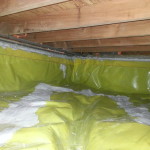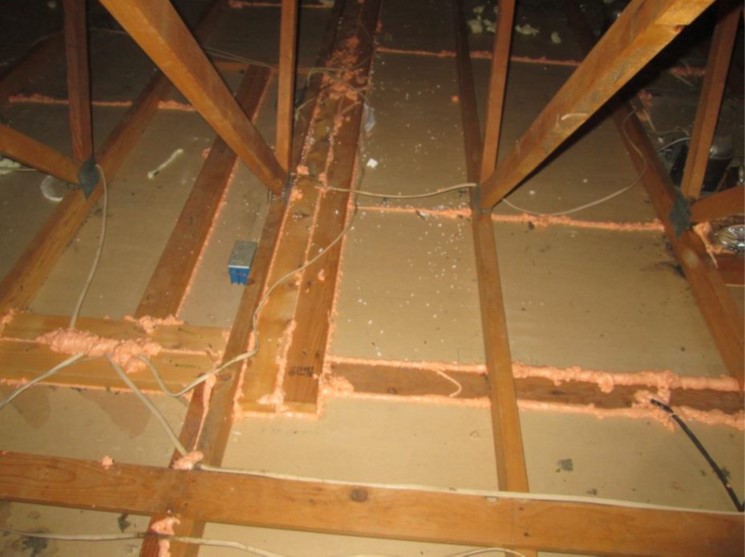Why is Air Sealing important?
The first goal of most home performance projects is to seal or “tighten” a house to control the separation between interior, conditioned space and exterior space. Information gained from our initial blower door test is used to determine the current air leakage and what areas have the best opportunity for improvement. While cold air coming through a leaky window is obvious to many homeowners; the less detectable leakage that may come from a homes crawlspace or attic can have a much greater effect on a home’s air quality and efficiency. This less detectable leakage can be cold, moist, dusty crawlspace air that is drawn into the house as hot air rises from the stack effect It can also be air that has traveled through dust, insulation and possibly pest contaminants from the attic into the house. By sealing a crawl space below the house and the attic stack effect is reduced significantly and a healthier, more comfortable and efficient living environment is created.
How does Air Sealing relate to Insulation?
Sealing the envelope also helps your home’s insulation perform better. Insulation is not designed to have air travel through it therefore, when there is air infiltration, your insulation R rating is downgraded significantly. By cutting down or eliminating the flow of air through the insulation performance is maximized.
How do you Air Seal?
Sealing the attic, or the ceiling, consists of two main parts. One is sealing interstitial cavities. Your house may have several interstitial cavities or attic bypasses that allow air to pass freely from the attic into the walls below. Sealing the areas such as where the duct system comes into the attic, flue pipes and at the tops of interior and exterior walls throughout the house is completed with products such as foam, fire rated drywall and plywood. The other is by using spray foam on the drywall along every wall in the attic. The seam along the top plate of the interior walls where vertical drywall meets the horizontal drywall is foamed in all accessible areas. We also foam every opening where air can get either into your house or into your wall cavities such as wiring and plumbing holes. In most houses that we look at there is a considerable air connection between the attic and living space which is a big energy, comfort and health issue.
What is Crawlspace Sealing?
 Sealing the crawl space below a house is done by laying out plastic throughout the entire crawl area and sealing it to the foundation walls. This stops air from being pulled from the crawl space and minimizes the stack effect on the house. After this is completed we measure moisture in the crawl space with a humidity data logger which takes temperature, humidity and dew point measurements every ten minutes for one year. This test is completed to double check that the crawl space sealing is effective.
Sealing the crawl space below a house is done by laying out plastic throughout the entire crawl area and sealing it to the foundation walls. This stops air from being pulled from the crawl space and minimizes the stack effect on the house. After this is completed we measure moisture in the crawl space with a humidity data logger which takes temperature, humidity and dew point measurements every ten minutes for one year. This test is completed to double check that the crawl space sealing is effective.
How is Air Sealing progress measured?
A blower door is in place during all air sealing work to monitor progress and provide a final reading of air changes per hour. The final air changes per hour reading is used to determine how the house is performing and if mechanical ventilation is required.
We measured our last 50 projects and they averaged 38% air leakage reduction. The only place we sealed were the attic, crawlspace, and we installed new zero leakage duct systems. That is a lot of air infiltration from area where we use respirators to work in. That same contaminated air was going into these homes before they were sealed. This is another reason why we advise people to not seal their windows before doing this work and adding ventilation.
Is Air Sealing cost effective?
Air sealing is an inexpensive job because there is no equipment for you to buy. It is normally the most cost effective measure to increase your homes performance, efficiency, comfort and health.
More air sealing Frequently Asked Questions (FAQs)
1) How do you Air Seal an attic with Insulation in it?
It is very difficult, but possible. A technician needs to move aside insulation, air seal the relevant parts of the attic floor, then move the insulation back. All this while wearing a full body suit, respirator and maneuvering very carefully around the attic. It is for this reason that sometimes the contractor and/or homeowner decide to first remove the existing insulation then re insulate with new insulation after the work is done. Although this comes with a cost, it can decrease the air sealing labor cost drastically and enormously improve the Air Sealing potential in the attic.
2) What are the material used in Air Sealing?
Expanding spray foam insulation canisters Spray foam insulation gun, Air Sealing tape, cut to fit plywood, cut to fit rigid foam board insulation, air sealing covers for recessed can lights.
3) What is a good Air Sealing goal?
A good target building leakage rate is 0.35 Air Changes per Hour (AC H). This can be calculated for a specific house based on the volume of the home and the tested Blower Door building leakage rate (in Cubic Feet per Minute at 50 pascals). Homes weren’t (and still usually are not) built to be air tight or with any air sealing measures. Your average house is far leakier than 0.35 ACH. It is important to note that at 70% of 0.35 ACH one hits what is called the Building Airflow Standard (BAS). Below this point, a homeowner should consider adding a fresh air ventilation system.
Get in contact:
[dropshadowbox align=”none” effect=”lifted-both” width=”640px” height=”” background_color=”#ffffff” border_width=”1″ border_color=”#dddddd” ]For more information about air sealing and building leakage, call (925) 363-4498 to speak to a technician or schedule an Energy Assessment. You can also e-mail: info@epbuilders.com[/dropshadowbox]
Read our Testimonials from happy homeowners!
Photos of the variety of Home Performance Services we provide on a weekly basis:
[nggallery id=27]
- More Services Below
- Energy Audit / Home Performance Analysis:
- Heating and Cooling
- Duct Systems
- Air Sealing
- Insulation
- Water Heating
- Crawlspace Sealing
- Green Building
- Indoor Air Quality
- Pool Pumps

